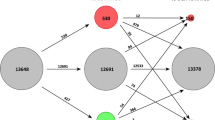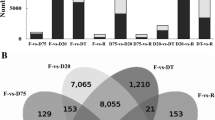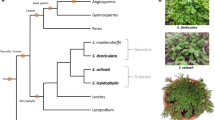Abstract
Main conclusion
Taxonomically restricted genes are known to contribute to the evolution of new traits. In Craterostigma plantagineum two of such genes are modulated during dehydration and rehydration and seem to contribute to a successful recovery after desiccation.
Abstract
The resurrection plant Craterostigma plantagineum can tolerate extreme water loss. Protective molecules linked to desiccation tolerance were identified in C. plantagineum but underlying mechanisms are far from being completely understood. A transcriptome analysis revealed several genes which could not be annotated and are, therefore, interesting candidates for understanding desiccation tolerance. Genes which occur only in some species are defined as orphan or taxonomically restricted genes (TRGs) and may be important for the evolution of new traits. Several of these TRGs are modulated in expression during dehydration/rehydration in C. plantagineum. Here we report the characterisation of two of these TRGs encoding a cysteine-rich rehydration-responsive protein 1 (CpCRP1) and an early dehydration-responsive protein 1 (CpEDR1). The involvement of CpCRP1 and CpEDR1 in different phases of the dehydration/rehydration cycle is shown by transcript and protein expression analysis. In silico sequence analyses predicted that both genes are likely to interact with other cellular components and are localised in two different cellular compartments. GFP fusion proteins demonstrated that CpCRP1 is secreted into the apoplasm, whereas CpEDR1 is imported into chloroplasts. Putative homologs of CpCRP1 and CpEDR1 were identified in Lindernia brevidens and Lindernia subracemosa which belong to the same family as C. plantagineum thus suggesting a recent evolution of the genes in this family. According to expression profiles, CpCRP1 may play a role in normal conditions and during rehydration, whereas CpEDR1 may be required for the acquisition of desiccation tolerance and protect photosynthetic structures during dehydration and rehydration.






Similar content being viewed by others
Explore related subjects
Discover the latest articles and news from researchers in related subjects, suggested using machine learning.References
Bartels D, Salamini F (2001) Desiccation tolerance in the resurrection plant Craterostigma plantagineum. A contribution to the study of drought tolerance at the molecular level. Plant Physiol 127(4):1346–1353
Bartels D, Schneider K, Terstappen G, Piatkowski D, Salamini F (1990) Molecular cloning of abscisic acid-modulated genes which are induced during desiccation of the resurrection plant Craterostigma plantagineum. Planta 181(1):27–34
Bartels D, Hanke C, Schneider K, Michel D, Salamini F (1992) A desiccation-related Elip-like gene from the resurrection plant Craterostigma plantagineum is regulated by light and ABA. EMBO J 11(8):2771–2778
Bartels D, Ditzer A, Furini A (2006) What can we learn from resurrection plants? In: Ribaut J (ed) Drought adaptation in cereals. Hayworth Publisher, Binghamton, pp 599–622
Benson DA, Karsch-Mizrachi I, Clark K, Lipman DJ, Ostell J, Sayers EW (2012) GenBank. Nucleic Acids Res 40(D1):D48–D53
Bernacchia G, Salamini F, Bartels D (1996) Molecular characterization of the rehydration process in the resurrection plant Craterostigma plantagineum. Plant Physiol 111(4):1043–1050
Bockel C, Salamini F, Bartels D (1998) Isolation and characterization of genes expressed during early events of the dehydration process in the resurrection plant Craterostigma plantagineum. J Plant Physiol 152(2–3):158–166
Camacho C, Coulouris G, Avagyan V, Ma N, Papadopoulos J, Bealer K, Madden T (2009) BLAST+: architecture and applications. BMC Bioinformatics 10(1):421
de Castro E, Sigrist CJ, Gattiker A, Bulliard V, Langendijk-Genevaux PS, Gasteiger E, Bairoch A, Hulo N (2006) ScanProsite: detection of PROSITE signature matches and ProRule-associated functional and structural residues in proteins. Nucleic Acids Res 34:W362–W365
Denecke J, Botterman J, Deblaere R (1990) Protein secretion in plant cells can occur via a default pathway. Plant Cell 2(1):51–59
Dinakar C, Bartels D (2012) Light response, oxidative stress management and nucleic acid stability in closely related Linderniaceae species differing in desiccation tolerance. Planta 236(2):541–555
Dinakar C, Bartels D (2013) Desiccation tolerance in resurrection plants: new insights from transcriptome, proteome and metabolome analysis. Front Plant Sci 4:482
Domingo C, Gomez MD, Canas L, Hernandez-Yago J, Conejero V, Vera P (1994) A novel extracellular matrix protein from tomato associated with lignified secondary cell walls. Plant Cell 6(8):1035–1047
Domingo C, Saurí A, Mansilla E, Conejero V, Vera P (1999) Identification of a novel peptide motif that mediates cross-linking of proteins to cell walls. Plant J 20(5):563–570
Drin G, Antonny B (2010) Amphipathic helices and membrane curvature. FEBS Lett 584(9):1840–1847
Emanuelsson O, Nielsen H, Heijne GV (1999) ChloroP, a neural network-based method for predicting chloroplast transit peptides and their cleavage sites. Protein Sci 8(5):978–984
Farrant JM (2000) A comparison of mechanisms of desiccation tolerance among three angiosperm resurrection plant species. Plant Ecol 151(1):29–39
Farrant JM, Vander Willigen C, Loffell DA, Bartsch S, Whittaker A (2003) An investigation into the role of light during desiccation of three angiosperm resurrection plants. Plant, Cell Environ 26(8):1275–1286
Farrant JM, Brandt W, Lindsey GG (2007) An overview of mechanisms of desiccation tolerance in selected angiosperm resurrection plants. Plant Stress 1(1):72–84
Feiz L, Irshad M, Pont-Lezica RF, Canut H, Jamet E (2006) Evaluation of cell wall preparations for proteomics: a new procedure for purifying cell walls from Arabidopsis hypocotyls. Plant Methods 2(1):10
Furini A, Koncz C, Salamini F, Bartels D (1997) High level transcription of a member of a repeated gene family confers dehydration tolerance to callus tissue of Craterostigma plantagineum. EMBO J 16(12):3599–3608
Gaff DF (1989) Responses of desiccation-tolerant “resurrection” plants to water stress. In: Kreeb KH, Richter H, Hinckley TM (eds) Structural and functional responses to environmental stresses: water shortages. SPB Academic, The Hague, pp 264–311
Gautier R, Douguet D, Antonny B, Drin G (2008) HELIQUEST: a web server to screen sequences with specific α-helical properties. Bioinformatics 24(18):2101–2102
Gechev T, Benina M, Obata T, Tohge T, Sujeeth N, Minkov I, Hille J, Temanni M-R, Marriott A, Bergström E, Thomas-Oates J, Antonio C, Mueller-Roeber B, Schippers J, Fernie A, Toneva V (2013) Molecular mechanisms of desiccation tolerance in the resurrection glacial relic Haberlea rhodopensis. Cell Mol Life Sci 70(40):689–709
Goodstein DM, Shu S, Howson R, Neupane R, Hayes RD, Fazo J, Mitros T, Dirks W, Hellsten U, Putnam N, Rokhsar DS (2012) Phytozome: a comparative platform for green plant genomics. Nucleic Acids Res 40(D1):D1178–D1186
Höfler K, Migsch H, Rottenburg W (1941) Über die Austrocknungresistenz landwirtschaftlicher Kulturpflanzen. Forschungsdienst 12:50–61
Horton P, Park KJ, Obayashi T, Fujita N, Harada H, Adams-Collier CJ, Nakai K (2007) WoLF PSORT: protein localization predictor. Nucleic Acids Res 35:W585–W587
Ingram J, Bartels D (1996) The molecular basis of dehydration tolerance in plants. Annu Rev Plant Biol 47(1):377–403
Khalturin K, Hemmrich G, Fraune S, Augustin R, Bosch TCG (2009) More than just orphans: are taxonomically-restricted genes important in evolution? Trends Genet 25(9):404–413
Kirch H-H, Röhrig H (2010) Affinity purification and determination of enzymatic activity of recombinantly expressed aldehyde dehydrogenases. In: Sunkar R (ed) Plant stress tolerance, vol 639., Methods in molecular biologyHumana Press, New York, pp 281–290
Laemmli UKU (1970) Cleavage of structural proteins during the assembly of the head of bacteriophage T4. Nature 227(5259):680–685
Larkin MA, Blackshields G, Brown NP, Chenna R, McGettigan PA, McWilliam H, Valentin F, Wallace IM, Wilm A, Lopez R, Thompson JD, Gibson TJ, Higgins DG (2007) Clustal W and Clustal X version 2.0. Bioinformatics 23(21):2947–2948
Leung J, Giraudat J (1998) Abscisic acid signal transduction. Annu Rev Plant Physiol Plant Mol Biol 49:199–222
Lupas A (1996) Coiled coils: new structures and new functions. Trends Biochem Sci 21(10):375–382
Lupas A, Van Dyke M, Stock J (1991) Predicting coiled coils from protein sequences. Science 252(5009):1162–1164
Moore JP, Le NT, Brandt WF, Driouich A, Farrant JM (2009) Towards a systems-based understanding of plant desiccation tolerance. Trends Plant Sci 14(2):110–117
Moore JP, Nguema-Ona EE, Vicré-Gibouin M, Sørensen I, Willats WG, Driouich A, Farrant JM (2013) Arabinose-rich polymers as an evolutionary strategy to plasticize resurrection plant cell walls against desiccation. Planta 237(3):739–754
Ohno S (1970) Evolution by gene duplication. Springer-Verlag, Heidelberg and New York
Oliver MJ, O’Mahony P, Wood AJ (1998) “To dryness and beyond”: preparation for the dried state and rehydration in vegetative desiccation-tolerant plants. Plant Growth Regul 24(3):193–201
Oliver M, Tuba Z, Mishler B (2000) The evolution of vegetative desiccation tolerance in land plants. Plant Ecol 151(1):85–100
Petersen J, Eriksson SK, Harryson P, Pierog S, Colby T, Bartels D, Röhrig H (2012) The lysine-rich motif of intrinsically disordered stress protein CDeT11-24 from Craterostigma plantagineum is responsible for phosphatidic acid binding and protection of enzymes from damaging effects caused by desiccation. J Exp Bot 63(13):4919–4929
Phillips JR, Hilbricht T, Salamini F, Bartels D (2002) A novel abscisic acid- and dehydration-responsive gene family from the resurrection plant Craterostigma plantagineum encodes a plastid-targeted protein with DNA-binding activity. Planta 215(2):258–266
Proost S, Van Bel M, Sterck L, Billiau K, Van Parys T, Van de Peer Y, Vandepoele K (2009) PLAZA: a comparative genomics resource to study gene and genome evolution in plants. Plant Cell 21(12):3718–3731
Prud’homme B, Gompel N, Carroll SB (2007) Emerging principles of regulatory evolution. Proc Natl Acad Sci USA 104(suppl 1):8605–8612
Rodrigo MJ, Bockel C, Blervacq AS, Bartels D (2004) The novel gene CpEdi-9 from the resurrection plant C. plantagineum encodes a hydrophilic protein and is expressed in mature seeds as well as in response to dehydration in leaf phloem tissues. Planta 219(4):579–589
Rodriguez MC, Edsgärd D, Hussain SS, Alquezar D, Rasmussen M, Gilbert T, Nielsen BH, Bartels D, Mundy J (2010) Transcriptomes of the desiccation-tolerant resurrection plant Craterostigma plantagineum. Plant J 63(2):212–228
Röhrig H, Schmidt J, Colby T, Bräutigam A, Hufnagel P, Bartels D (2006) Desiccation of the resurrection plant Craterostigma plantagineum induces dynamic changes in protein phosphorylation. Plant, Cell Environ 29(8):1606–1617
Roy A, Kucukural A, Zhang Y (2010) I-TASSER: a unified platform for automated protein structure and function prediction. Nat Protoc 5(4):725–738
Sambrook J, Fritsch EF, Maniatis T (1989) Molecular cloning: a laboratory manual, 2nd edn. Cold Spring Harbor Laboratory Press, New York
Scheibe R, Beck E (2011) Drought, desiccation, and oxidative stress. In: Lüttge U, Beck E, Bartels D (eds) Plant desiccation tolerance, vol 215., Ecological studiesSpringer, Berlin Heidelberg, pp 209–231
Schmidt J, John M, Wieneke U, Krüssmann H-D, Schell J (1986) Expression of the nodulation gene nodA in Rhizobium meliloti and localization of the gene product in the cytosol. Proc Natl Acad Sci USA 83(24):9581–9585
Schneider K, Wells B, Schmelzer E, Salamini F, Bartels D (1993) Desiccation leads to the rapid accumulation of both cytosolic and chloroplastic proteins in the resurrection plant Craterostigma plantagineum Hochst. Planta 189(1):120–131
Sherwin H, Farrant J (1998) Protection mechanisms against excess light in the resurrection plants Craterostigma wilmsii and Xerophyta viscosa. Plant Growth Regul 24(3):203–210
Towbin H, Staehelin T, Gordon J (1979) Electrophoretic transfer of proteins from polyacrylamide gels to nitrocellulose sheets: procedure and some applications. Proc Natl Acad Sci USA 76(9):4350–4354
Valenzuela-Avendaño JP, Mota IAE, Uc GL, Perera RS, Valenzuela-Soto EM, Aguilar JJZ (2005) Use of a simple method to isolate intact RNA from partially hydrated Selaginella lepidophylla plants. Plant Mol Biol Rep 23(2):199–200
van den Dries N, Facchinelli F, Giarola V, Phillips JR, Bartels D (2011) Comparative analysis of LEA-like 11-24 gene expression and regulation in related plant species within the Linderniaceae that differ in desiccation tolerance. New Phytol 190(1):75–88
Wang WX, Pelah D, Alergand T, Shoseyov O, Altman A (2002) Characterization of SP1, a stress-responsive, boiling-soluble, homo-oligomeric protein from aspen. Plant Physiol 130(2):865–875
Wang W, Scali M, Vignani R, Spadafora A, Sensi E, Mazzuca S, Cresti M (2003) Protein extraction for two-dimensional electrophoresis from olive leaf, a plant tissue containing high levels of interfering compounds. Electrophoresis 24(14):2369–2375
Willige BC, Kutzer M, Tebartz F, Bartels D (2009) Subcellular localization and enzymatic properties of differentially expressed transketolase genes isolated from the desiccation tolerant resurrection plant Craterostigma plantagineum. Planta 229(3):659–666
Willigen CV, Pammenter NW, Jaffer MA, Mundree SG, Farrant JM (2003) An ultrastructural study using anhydrous fixation of Eragrostis nindensis, a resurrection grass with both desiccation-tolerant and -sensitive tissues. Funct Plant Biol 30(3):281
Wilson GA, Bertrand N, Patel Y, Hughes JB, Feil EJ, Field D (2005) Orphans as taxonomically restricted and ecologically important genes. Microbiology 151(8):2499–2501
Xue B, Dunbrack RL, Williams RW, Dunker AK, Uversky VN (2010) PONDR-FIT: a meta-predictor of intrinsically disordered amino acids. Biochim Biophys Acta 1804(4):996–1010
Acknowledgments
We thank C. Buchholz for providing plant material, N. Jung and H. Bertram for help with some PCR experiments, A. Sergeeva for the immunoblot analysis of cell wall proteins and B. Buchen for critically reading the manuscript. Part of the work was supported by the Deutsche Forschungsgemeinschaft grant BA 712/9-2.
Conflict of interest
The authors declare that they have no conflict of interest.
Author information
Authors and Affiliations
Corresponding author
Electronic supplementary material
Below is the link to the electronic supplementary material.
Rights and permissions
About this article
Cite this article
Giarola, V., Krey, S., Frerichs, A. et al. Taxonomically restricted genes of Craterostigma plantagineum are modulated in their expression during dehydration and rehydration. Planta 241, 193–208 (2015). https://doi.org/10.1007/s00425-014-2175-2
Received:
Accepted:
Published:
Issue Date:
DOI: https://doi.org/10.1007/s00425-014-2175-2




